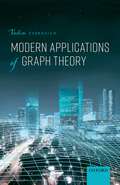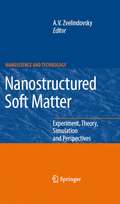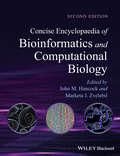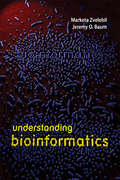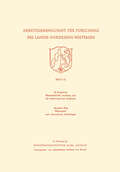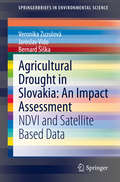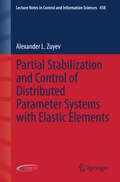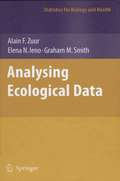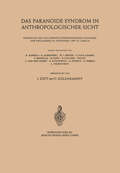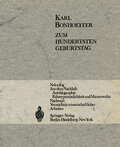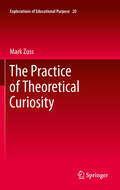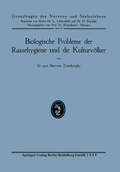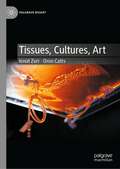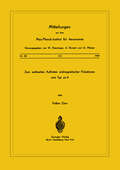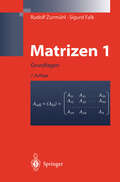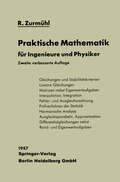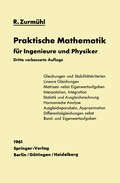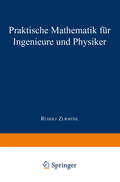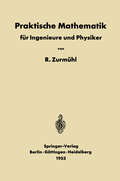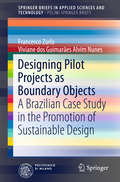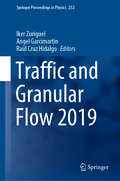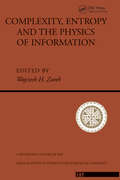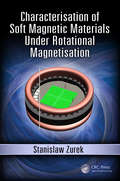- Table View
- List View
Modern Applications of Graph Theory
by Vadim ZverovichModern Applications of Graph Theory discusses many cutting-edge applications of graph theory, such as traffic networks, navigable networks and optimal routing for emergency response, placement of electric vehicle charging stations, and graph-theoretic methods in molecular epidemiology. Due to the rapid growth of research in this field, the focus of the book is on the up-to-date development of these applications and the mathematical methods used to tackle them. Ideal for researchers, engineers, transport planners and emergency response specialists who are interested in graph theory applications, Modern Applications of Graph Theory can also be used as teaching material. In addition to up-to-date descriptions of the applications, it includes extensive exercises and their solutions, mimicking practical, real-life situations. Furthermore, there is an introductory chapter, which provides an overview of basic applications and algorithms of graph theory. The book includes over 120 illustrations and tables.
Nanostructured Soft Matter: Experiment, Theory, Simulation and Perspectives (NanoScience and Technology)
by A. V. ZvelindovskyThis book provides an interdisciplinary overview of a new and broad class of materials under the unifying name Nanostructured Soft Matter. It covers materials ranging from short amphiphilic molecules to block copolymers, proteins, colloids and their composites, microemulsions and bio-inspired systems such as vesicles.
Concise Encyclopaedia of Bioinformatics and Computational Biology
by Marketa J. Zvelebil John M. HancockConcise Encyclopaedia of Bioinformatics and Computational Biology, 2nd Edition is a fully revised and updated version of this acclaimed resource. The book provides definitions and often explanations of over 1000 words, phrases and concepts relating to this fast-moving and exciting field, offering a convenient, one-stop summary of the core knowledge in the area. This second edition is an invaluable resource for students, researchers and academics.
Understanding Bioinformatics
by Marketa J Zvelebil Jeremy O. BaumSuitable for advanced undergraduates and postgraduates, Understanding Bioinformatics provides a definitive guide to this vibrant and evolving discipline. The book takes a conceptual approach. It guides the reader from first principles through to an understanding of the computational techniques and the key algorithms. Understanding Bioinformatics is an invaluable companion for students from their first encounter with the subject through to more advanced studies. The book is divided into seven parts, with the opening part introducing the basics of nucleic acids, proteins and databases. Subsequent parts are divided into 'Applications' and 'Theory' Chapters, allowing readers to focus their attention effectively. In each section, the Applications Chapter provides a fast and straightforward route to understanding the main concepts and 'getting started'. Each of these is then followed by Theory Chapters which give greater detail and present the underlying mathematics. In Part 2, Sequence Alignments, the Applications Chapter shows the reader how to get started on producing and analyzing sequence alignments, and using sequences for database searching, while the next two chapters look closely at the more advanced techniques and the mathematical algorithms involved. Part 3 covers evolutionary processes and shows how bioinformatics can be used to help build phylogenetic trees. Part 4 looks at the characteristics of whole genomes. In Parts 5 and 6 the focus turns to secondary and tertiary structure – predicting structural conformation and analysing structure-function relationships. The last part surveys methods of analyzing data from a set of genes or proteins of an organism and is rounded off with an overview of systems biology. The writing style of Understanding Bioinformatics is notable for its clarity, while the extensive, full-color artwork has been designed to present the key concepts with simplicity and consistency. Each chapter uses mind-maps and flow diagrams to give an overview of the conceptual links within each topic.
Wissenschaftliche Forschung und die Auswertung ihrer Ergebnisse. Wissenschaft und internationale Beziehungen (Arbeitsgemeinschaft für Forschung des Landes Nordrhein-Westfalen)
by M. ZvegintzovThe Inorganic Radiochemistry of Heavy Elements: Methods for Studying Gaseous Compounds
by Ivo ZváraWritten by one of the founders of gas-chromotagraphic methods in radiochemistry, this book attempts a genuine first. It is a discussion of the state of art of heavy element inorganic radiochemistry. It aims to be a real addition to the understanding of this crucial topic. Written as much for newcomers to the field as experts, its goal is also to stimulate wider use of the advantageous gas phase techniques for common elements.
Agricultural Drought in Slovakia: NDVI and Satellite Based Data (SpringerBriefs in Environmental Science)
by Veronika Zuzulová Jaroslav Vido Bernard ŠiškaThis book gives an insight into the evaluation of drought in Slovakia and provides an assessment of Normalized Difference Vegetation Index (NDVI) as a method suitable for an evaluation of drought in agricultural land. Dry seasons in the time series from 1960 to 2014 were determined according to the monthly Palmer Drought Severity Index (PDSI). The field research was carried out on 12 sites including western Slovakia, Prešov, Trnava and Nitra regions. Data collected from satellite imagery, climate data analyses and drought indices was analysed to determine the value of NDVI as an evaluation tool.
Partial Stabilization and Control of Distributed Parameter Systems with Elastic Elements (Lecture Notes in Control and Information Sciences #458)
by Alexander L. ZuyevThis monograph provides a rigorous treatment of problems related to partial asymptotic stability and controllability for models of flexible structures described by coupled nonlinear ordinary and partial differential equations or equations in abstract spaces. The text is self-contained, beginning with some basic results from the theory of continuous semigroups of operators in Banach spaces. The problem of partial asymptotic stability with respect to a continuous functional is then considered for a class of abstract multivalued systems on a metric space. Next, the results of this study are applied to the study of a rotating body with elastic attachments. Professor Zuyev demonstrates that the equilibrium cannot be made strongly asymptotically stable in the general case, motivating consideration of the problem of partial stabilization with respect to the functional that represents “averaged” oscillations. The book’s focus moves on to spillover analysis for infinite-dimensional systems with finite-dimensional controls. It is shown that a family of L2-minimal controls, corresponding to low frequencies, can be used to obtain approximate solutions of the steering problem for the complete system.The book turns from the examination of an abstract class of systems to particular physical examples. Timoshenko beam theory is exploited in studying a mathematical model of a flexible-link manipulator. Finally, a mechanical system consisting of a rigid body with the Kirchhoff plate is considered. Having established that such a system is not controllable in general, sufficient controllability conditions are proposed for the dynamics on an invariant manifold.Academic researchers and graduate students interested in control theory and mechanical engineering will find Partial Stabilization and Control of Distributed-Parameter Systems with Elastic Elements a valuable and authoritative resource for investigations on the subject of partial stabilization.
Analyzing Ecological Data (Statistics for Biology and Health)
by Alain Zuur Elena N. Ieno Graham M. SmithThis book provides a practical introduction to analyzing ecological data using real data sets. The first part gives a largely non-mathematical introduction to data exploration, univariate methods (including GAM and mixed modeling techniques), multivariate analysis, time series analysis, and spatial statistics. The second part provides 17 case studies. The case studies include topics ranging from terrestrial ecology to marine biology and can be used as a template for a reader’s own data analysis. Data from all case studies are available from www.highstat.com. Guidance on software is provided in the book.
Das Paranoide Syndrom in Anthropologischer Sicht: Symposion auf dem Zweiten Internationalen Kongress für Psychiatrie im September 1957 in Zürich
by Jürg Zutt Caspar KulenkampffThe Practice of Theoretical Curiosity (Explorations of Educational Purpose #20)
by Mark ZussThe desire for knowledge is an abiding facet of human experience and cultural development. This work documents curiosity as a sociohistorical force initiating research across the disciplines. Projects generated by theoretical curiosity are presented as historical and material practices emerging as expressions of embodied knowledge and experience. The shifting cultural, philosophical and practical relations between theory and curiosity are situated within classical, medieval, early modern and contemporary communities of practice. The Practice of Theoretical Curiosity advocates for a critical, aesthetic engagement in everyday life. Its purpose is to examine the pedagogical grounds and questions that motivate research programs in the sciences, education, technoculture and post-war social movements. Theoretical curiosity continually resists disciplinary limits. It is a core, embodied process uniting human pursuits of knowledge and power. This inquiry into inquiry itself offers an appreciation of the vital continuity between the senses, perception, and affect and concept development. It is informed by a critical reading of phenomenology as the embodied practice of researchers. This study sponsors a deepening of theory in practice and the practice of theoretical exploration. As a contribution to pedagogical practice, it offers a historical critique of the usually unquestioned philosophical, political and ethical grounds for educational, scientific and social research. The Practice of Theoretical Curiosity profiles significant alliances and persona as agents for the pursuit of novel and often controversial research, adventures and discovery. It claims that the place of technology and the technical is the primary channel for contemporary inquiry. The technosciences of genomics, artificial life and astrobiology are considered as contemporary extensions of a perennial desire to pursue and resist the limits of existing knowledge and representation.
Biologische Probleme der Rassehygiene und die Kulturvölker (Grenzfragen des Nerven- und Seelenlebens)
by Stavros ZurukzogluDieser Buchtitel ist Teil des Digitalisierungsprojekts Springer Book Archives mit Publikationen, die seit den Anfängen des Verlags von 1842 erschienen sind. Der Verlag stellt mit diesem Archiv Quellen für die historische wie auch die disziplingeschichtliche Forschung zur Verfügung, die jeweils im historischen Kontext betrachtet werden müssen. Dieser Titel erschien in der Zeit vor 1945 und wird daher in seiner zeittypischen politisch-ideologischen Ausrichtung vom Verlag nicht beworben.
Tissues, Cultures, Art (Palgrave BioArt)
by Ionat Zurr Oron CattsTissues, Cultures, Art narrates the twenty-five years of collaborative and sometimes provocative artistic practice and scholarly thought of Catts & Zurr, who pioneered the use of regenerative biology techniques to create Semi-Living art using living cells, tissues, and technological surrogate bodies. Through hands-on work in biological laboratories, the authors researched concepts such as partial-life and DNA-Chauvinism and explored the fantasies of living in a technologically mediated victimless utopia. The authors delve into life’s resistance to reductionism, systemisation and control, asking whether there is something unique to life without the need to resort to metaphysics. Their practices reach beyond the confines of art and are often cited as precursors to the cellular agriculture and biofabrication industries. Through a hybrid of personal reflections, poetics, and anecdotes with a more rigorous, scholarly approach – all illustrated with artworks - the authors present a critical view on the use of life as a raw material for human manipulation.
Zum Weltweiten Auftreten Erdmagnetischer Pulsationen vom Typ PC 4 (Mitteilungen aus dem Max-Planck-Institut für Aeronomie #38)
by V. ZürnMatrizen und ihre Anwendungen 1: Grundlagen Für Ingenieure, Physiker und Angewandte Mathematiker (Klassiker der Technik #30)
by Rudolf Zurmühl Sigurd FalkDas Buch behandelt Matrizengleichungen und -funktionen sowie die computergerechte Darstellung und Lösung der Bewegungsgleichungen von Schwingungssystemen mit endlich vielen Freiheitsgraden und führt in die Grundlagen der Näherungsmethoden von Rayleigh und Ritz ein. Das Eigenwertproblem wird, anders als sonst üblich, von einem allgemeinen Standpunkt aus betrachtet. Dadurch gewinnt die Darstellung an Verständlichkeit und an Anwendungsbreite. Das Buch ist sowohl für Studierende als auch für Physiker und Ingenieure in der Praxis geschrieben.
Praktische Mathematik: für Ingenieure und Physiker
by Rudolf ZurmühlDas Buch ist gedacht als eine Ergänzung und Fortführung der mathematischen Grundlagenvorlesung der Technischen Hochschule. Es möchte den jungen Ingenieurstudenten zu einer über diese Vorlesung hinausgehenden Beschäftigung mit jenem Zweig der Mathematik an regen, der für die zahlenmäßige Behandlung von Ingenieuraufgaben aller Art grundlegend ist: mit den numerischen V erfahren der praktischen Mathematik. In diese Methoden, ihre Theorie und ihre praktische Hand habung führt es ein, wobei gleicher Wert auf klare Entwicklung der theoretischen Grundgedanken wie auf Einzelheiten der Zahlen rechnung gelegt wird. Aber auch dem in der Praxis tätigen Ingenieur möchte das Buch eine Hilfe sein, wenn er bei der Durchführung seiner Aufgaben vorder Notwendigkeit steht, auf numerische V erfahren zurück zugreifen. Ein Buch, das sich an Ingenieure und Physiker wendet, muß in mancher Hinsicht anders abgefaßt sein als ein für Mathematiker be stimmtes. Es soll gewiß nicht weniger zuverlässig und einwandfrei sein. Aber während der Mathematiker in die Lage versetzt werden soll, selbst aktiv an der Entwicklung neuer Methoden mitzuarbeiten, sollen Physi ker und Ingenieur in erster Linie die praktische Handhabung der Metho den erlernen, um sie als Hilfsmittel für ihre eigentliche Berufsarbeit anzuwenden. Damit sie das sinnvoll und richtig können, müssen sie freilich die mathematischen Grundlagen eines Verfahrens voll verstan den haben. Mit einer bloßen Rezeptsammlung ist auch ihnen durchaus nicht gedient.
Praktische Mathematik für Ingenieure und Physiker
by Rudolf Zurmühl426 man fordert also Anfangs- und Endordinate der Lösung y (x) im Inter vall (a, b), Abb. 112. An Stelle der Randordinaten (sogenannte erste Randwertaufgabe) lassen sich auch die Randsteigungen y' (a), y' (b) . Y fordern (zweite Randwertaufgabe) oder schließ lich eine Linearkombination zwischen Ordinaten und Steigungen (dritte Randwertaufgabe). Alle jl diese Aufgaben oder auch ihre Kombinationen treten in den Anwendungen auf. . :c Ähnlich wie bei der Anfangswertaufgabe wird Abb. 112 Zur Randwertaufgabe man bei formelmäßiger Lösung versuchen, die in der allgemeinen Lösung enthaltenen freien Integratlonskonstanten aus den beiden Randbedingungen zu bestimmen und so die fragliche Sonderlösung y(x) festzulegen. Prinzipiell scheint sich gegenüber der Anfangswertaufgabe damit kaum etwas geändert zu haben. Bei der Durchführung derartiger Aufgaben aber zeigt sich sehr bald, daß sie im Gegensatz zur Anfangswertaufgabe nicht mehr in jedem Falle lösbar sind. Es treten hier also neue charakteristische Schwierigkeiten auf, zu deren Überwindung besondere Überlegungen notwendig werden. Aber auch die Behandlungsmethoden, insbesondere die uns vornehmlich interessierenden Näherungsverfahren, sind von denen der Anfangswertaufgaben grundverschieden, so daß wir es hier in der Tat mit einem neuen und im übrigen höchst reizvollen Gebiet der praktischen Mathematik zu tun haben, bei dem auch theoretische Fragen mehr als bisher in den Vordergrund treten werden. Die charakteristische Schwierigkeit des Randwertproblems sei an folgendem einfachen Beispiel erläutert. 1. Beispiel: Gegeben sei die - lineare - Differentialgleichung y" + y = 0 mit den Randbedingungen y(O) = 1, y(2) = O.
Designing Pilot Projects as Boundary Objects: A Brazilian Case Study in the Promotion of Sustainable Design (SpringerBriefs in Applied Sciences and Technology)
by Francesco Zurlo Viviane dos NunesThis book describes a collaborative Design Pilot Project held in Brazil (called MODU.Lares) involving micro and small enterprises and other actors in the furniture sector. The experience was based on an action research method and evaluated by using a tool, in order to assess the value of pilot project as a boundary object capable of fostering innovation and sustainability. The impact of the Design Pilot Project in triggering change in a fragmented local system with a poor environmental and social record, as well as management and innovation issues, were assessed with the help of the same tool, taking into account environmental, technological, economic, sociocultural, and organizational indicators. The collaborative network established was chiefly based on four elements: prototypes, meetings, exhibitions and the Pilot Project (as an overall process). The results indeed demonstrate that a Design Pilot Project can be a valid instrument for establishing a collaborative environment that promotes sustainability and innovation, particularly in contexts with a weak associative culture. Such collaborative projects can constitute the first step in a design policy cycle in developing countries, contributing to the definition of ideas and objectives among local stakeholders, minimizing the risks of failure, and increasing the chances of receiving governmental support.
Traffic and Granular Flow 2019 (Springer Proceedings in Physics #252)
by Iker Zuriguel Angel Garcimartín Raúl Cruz HidalgoThis book gathers contributions on a variety of flowing collective systems. While primarily focusing on pedestrian dynamics, they also reflect the latest developments in areas such as vehicular traffic and granular flows and address related emerging topics such as self-propelled particles, data transport, swarm behavior, intercellular transport, and collective dynamics of biological systems. Combining fundamental research and practical applications in the various fields discussed, the book offers a valuable asset for researchers and practitioners alike.
Complexity, Entropy And The Physics Of Information
by Wojciech H. ZurekA must have for those with a deep commitment to the second law of thermodynamics, entropy, and information theory.
Complexity, Entropy And The Physics Of Information (Santa Fe Institute Ser)
by Wojciech H. ZurekA must have for those with a deep commitment to the second law of thermodynamics, entropy, and information theory.
Characterisation of Soft Magnetic Materials Under Rotational Magnetisation
by Stanislaw ZurekThe book presents practical aspects related to the measurement of rotational power loss in soft magnetic materials. The book furthermore focuses on practical aspects of performing such measurements, the associated difficulties as well as solutions to the most common problems. Numerous practical aspects, hands-on experience, and most commonly encountered pitfalls are heavily discussed in the book. The text begins with introduction to magnetism, then follows with definitions of measurement methods of rotational power loss from physical viewpoint. Two chapters describe and detail the various sensors which can be employed for such measurements as well as all the aspects of designing, making, and using a magnetising apparatus. A synthesis of the likely optimal design of a magnetising apparatus is also given, preceded with the full reasoning based on all the research carried out to date. Characterisation of Soft Magnetic Materials Under Rotational Magnetisation serves as an excellent starting point for any student having to perform magnetic measurements under rotational magnetisation, but also under 1D, 2D or 3D excitation. Because the methods, sensors, and apparatus are extensively discussed it will also be a great reference for more senior researchers and experts in the field. There is a whole chapter devoted to analysis of measurement uncertainty. This subject is rarely published for magnetic measurements, which makes it more difficult for all researchers to understand the concepts and methodology used in uncertainty estimation. This chapter not only introduces the whole subject, but also provides multiple step-by-step examples which can be easily followed, from very simple cases to much more complex ones. All equations are presented with full SI units which greatly helps in practical application of the presented methodology. Each chapter is written in such a way that it can be studied on its own, so that the reader can focus only on the specific aspects, as required.
